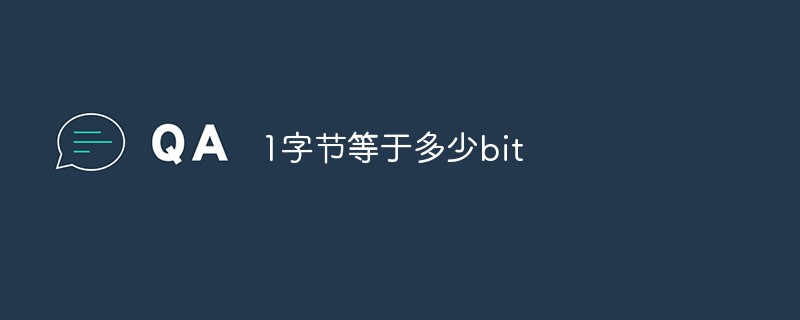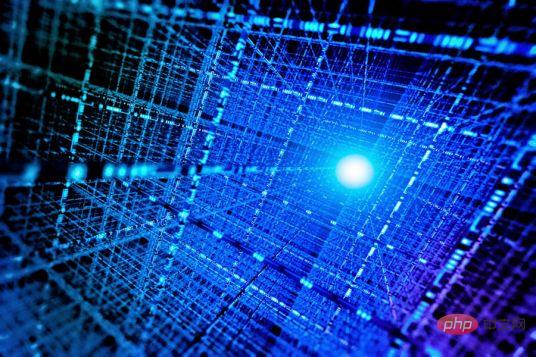1 byte equals how many bits
1 byte is equal to 8 bits (bit). In the binary number system, each 0 or 1 is a bit (bit), and a bit is the smallest unit of data storage; every 8 bits (bit, abbreviated as b) constitute a byte (Byte), so "1 byte ( Byte) = 8 bits”. In most computer systems, a byte is an 8-bit unit of data. Most computers use a byte to represent a character, number, or other character.

The operating environment of this tutorial: Windows 7 system, Dell G3 computer.
1 byte is 8 bits (bit), that is: 1byte = 8bit.
Byte (Byte) is a unit of measurement used by computer information technology to measure storage capacity. It also represents data types and language characters in some computer programming languages.
bit (bit), a computer term, is a unit of information and is transliterated from the English BIT. It is also a bit in a binary number, a measurement unit of information, and the smallest unit of information.
In the binary number system, each 0 or 1 is a bit, and a bit is the smallest unit of data storage. Among them, 8bit is called a byte (Byte) . The number of CPU bits in a computer refers to the maximum number of bits that the CPU can process at one time. For example, the CPU of a 32-bit computer can handle up to 32 bits of data at a time.

Data storage is in "byte" (Byte) as the unit, and data transmission is mostly in "bit" (bit, also known as "bit").A bit represents a 0 or 1 (i.e. binary), and every 8 bits (bit, abbreviated as b) constitute a byte (Byte, abbreviated as B) , which is the smallest level of information unit.
In most computer systems, a byte is an 8-bit long data unit. Most computers use a byte to represent a character, number, or other character. A byte can also represent a series of binary bits. In some computer systems, 4 bytes represent a word, which is the unit of data that the computer can efficiently process when executing instructions. Some language descriptions require 2 bytes to represent a character, which is called a double-byte character set. Some processors are capable of handling double-byte or single-byte instructions.
Unit conversion
Information storage is a measure of the amount of programs and data stored in memory. Its main unit of measurement is bytes, with 1 byte (Byte) equal to 8 bits (b) binary. Bit (Binary Digits): stores a binary number, that is, 0 or 1, which is the smallest storage unit. 8 binary digits are a byte unit. An English letter (regardless of case) occupies one byte of space, and a Chinese character occupies two bytes of space. English punctuation occupies one byte, and Chinese punctuation occupies two bytes
1 byte (Byte) = 8 bits (bit)
1KB(Kilobyte, kilobyte)=1024B
1MB(Megabyte, megabyte)=1024KB
1GB(Gigabyte, Jizi Trillionbyte, gigabyte)=1024MB
1TB(Trillionbyte, terabyte)=1024GB
1PB(Petabyte, Exabyte, petabyte) = 1024TB
- ##1EB(Exabyte, exabyte) = 1024PB
- 1ZB(Zettabyte, ten trillion bytes, zettabytes) = 1024EB
- 1YB(Yotabyte, one hundred trillion bytes, yaobytes) = 1024ZB
- 1BB(Brontobyte, billions of billions of bytes)=1024YB
Extended knowledge: words and word length
- Word (Word)In a computer, a string of numbers that are processed or calculated as a whole is called a computer word, or word for short. Words are usually divided into bytes (each byte is usually 8 bits). In memory, each cell typically stores one word. Therefore each word is addressable. The length of a word is expressed in bits.
- Word lengthThe number of bits contained in each word of a computer is called the word length. The calculated word length refers to the number of binary digits it can process at one time. . Generally, the word length of large computers is 32-64 bits, that of small computers is 12-32 bits, and that of microcomputers is 4-16 bits. Word length is an important factor in measuring computer performance.
FAQ column!
The above is the detailed content of 1 byte equals how many bits. For more information, please follow other related articles on the PHP Chinese website!

Hot AI Tools

Undresser.AI Undress
AI-powered app for creating realistic nude photos

AI Clothes Remover
Online AI tool for removing clothes from photos.

Undress AI Tool
Undress images for free

Clothoff.io
AI clothes remover

Video Face Swap
Swap faces in any video effortlessly with our completely free AI face swap tool!

Hot Article

Hot Tools

Notepad++7.3.1
Easy-to-use and free code editor

SublimeText3 Chinese version
Chinese version, very easy to use

Zend Studio 13.0.1
Powerful PHP integrated development environment

Dreamweaver CS6
Visual web development tools

SublimeText3 Mac version
God-level code editing software (SublimeText3)

Hot Topics
 1386
1386
 52
52
 1MB of storage capacity is equivalent to how many bytes
Mar 03, 2023 pm 05:42 PM
1MB of storage capacity is equivalent to how many bytes
Mar 03, 2023 pm 05:42 PM
1MB of storage capacity is equivalent to 2 to the 20th power bytes, or 1,048,576 bytes. MB is a storage unit in computers, pronounced as "mega"; because 1MB is equal to 1024KB, and 1KB is equal to 1024B (bytes), so 1MB is equal to 1048576 (1024 *1024) bytes.
 How many bytes does 128mb mean?
Nov 29, 2022 am 10:35 AM
How many bytes does 128mb mean?
Nov 29, 2022 am 10:35 AM
128mb refers to 134217728 bytes; the byte conversion formula is "1MB=1024KB=1048576B=8388608bit", which means that 1048576 English letters and 524288 Chinese characters can be saved; the traffic unit conversion formula is 1GB=1024MB, 1MB=1024KB, 1KB= 1024B.
 1 bit equals how many bytes
Mar 09, 2023 pm 03:11 PM
1 bit equals how many bytes
Mar 09, 2023 pm 03:11 PM
1 bit is equal to one-eighth of a byte. In the binary number system, each 0 or 1 is a bit (bit), and a bit is the smallest unit of data storage; every 8 bits (bit, abbreviated as b) constitute a byte (Byte), so "1 byte ( Byte) = 8 bits”. In most computer systems, a byte is an 8-bit (bit) long data unit. Most computers use a byte to represent a character, number, or other character.
 How many bytes does one ascii character occupy?
Mar 09, 2023 pm 03:49 PM
How many bytes does one ascii character occupy?
Mar 09, 2023 pm 03:49 PM
One ascii character occupies 1 byte. ASCII code characters are represented by 7-bit or 8-bit binary encoding in the computer and are stored in one byte, that is, one ASCII code occupies one byte. ASCII code can be divided into standard ASCII code and extended ASCII code. Standard ASCII code is also called basic ASCII code. It uses 7-bit binary numbers (the remaining 1 binary digit is 0) to represent all uppercase and lowercase letters, and the numbers 0 to 9. Punctuation marks, and special control characters used in American English.
 How many bytes do utf8 encoded Chinese characters occupy?
Feb 21, 2023 am 11:40 AM
How many bytes do utf8 encoded Chinese characters occupy?
Feb 21, 2023 am 11:40 AM
UTF8 encoded Chinese characters occupy 3 bytes. In UTF-8 encoding, one Chinese character is equal to three bytes, and one Chinese punctuation mark occupies three bytes; while in Unicode encoding, one Chinese character (including traditional Chinese) is equal to two bytes. UTF-8 uses 1~4 bytes to encode each character. One US-ASCIl character only needs 1 byte to encode. Latin, Greek, Cyrillic, Armenian, and Hebrew with diacritical marks. , Arabic, Syriac and other letters require 2-byte encoding.
 How many bytes does an ascii code occupy?
Sep 07, 2023 pm 04:03 PM
How many bytes does an ascii code occupy?
Sep 07, 2023 pm 04:03 PM
An ASCII code occupies one byte. ASCII code is a coding standard used to represent characters. It uses 7-bit binary numbers to represent 128 different characters, including letters, numbers, punctuation marks, special characters, etc. A byte is the basic unit of computer storage unit. It consists of 8 binary bits. Each binary bit can be 0 or 1. One byte can represent 256 different values, so it can represent all characters in the ASCII code.
 Detailed explanation of the method of converting int type to bytes in PHP
Mar 06, 2024 pm 06:18 PM
Detailed explanation of the method of converting int type to bytes in PHP
Mar 06, 2024 pm 06:18 PM
Detailed explanation of the method of converting int type to byte in PHP In PHP, we often need to convert the integer type (int) to the byte (Byte) type, such as when dealing with network data transmission, file processing, or encryption algorithms. This article will introduce in detail how to convert the int type to the byte type and provide specific code examples. 1. The relationship between int type and byte In the computer field, the basic data type int represents an integer, while byte (Byte) is a computer storage unit, usually 8-bit binary data
 4kb indicates how many bytes there are in the storage unit
Feb 28, 2023 pm 12:12 PM
4kb indicates how many bytes there are in the storage unit
Feb 28, 2023 pm 12:12 PM
4KB means that the storage unit is 4096 bytes. KB refers to kilobyte, which is a multiple form of computer data storage unit byte. A kilobyte is based on the power of 2, that is, a kilobyte (1KB) is equal to 1024 bytes (B ); therefore "4KB=4*1024B=4096B", that is, 4KB represents 4096 bytes.



